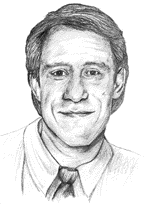 |
Each and every day, brochures land on my desk at STOCKS & COMMODITIES, announcing trading seminars that will teach me daytrading. The benefits are numerous and tempting: I could make money at home, I could be completely in control, I could trade anytime I want, I could dress in a suit or shorts if I so chose, I could buy myself a new Mercedes, I could have time for my spouse and kids, and I would never have to worry about getting hired or fired. Sounds good, doesn't it?
"A professional trader," according to the Securities Trading Institute, "identifies what the trend is, as it happens, and rides it. É To a trained professional trader, that up and down movement is actually predictable -- very predictable."
In the real world, actual professional traders on trading platforms wish they had it so easy. Mailing such promises to thousands of people just taps age-old greed: something for virtually nothing. Well, not exactly nothing: there's the thousands of dollars spent on seminar fees to become a "trained professional trader."
In the real world, a trader, whether novice or professional, enters a competitive realm where thousands of others actually seek his harm or, at least, his money. Events drive traders back and forth in a random, chaotic frenzy from which an "orderly" market discerns instantaneous value on a more or less continuous basis, depending on who is calling in orders at the moment. You are no more in control of this than you are of the weather.
Do experienced traders have a responsibility to point this out to novices? I think they do. How about a letter to the editor of a local newspaper that runs ads like this? How about speaking up online in chat groups? How about asking for documentation of outrageous claims? And don't be deterred by the few who survive and thrive. Those who lost their shirts just aren't speaking up as loudly.
In contrast, the task of discerning typical market behavior, let alone exploiting it, is highlighted in Stéphane Reverre's article this month, "Trade Against The Gap." Reverre, who was an equity derivatives trader at one time, was able to put some descriptive statistics to the tendency to close large moves in prices, what many would call "filling the gap" or "trading back into the gap." His evidence is that this may be asymmetrical, different for an up gap than for a down gap and different depending on the size of the move. It took detailed study, presented as graphs, and careful analysis to see all this. It wasn't a seat-of-the-pants result. Nor were the returns outlandish. They were an edge that a careful trader could amplify with technique and capital. This is the real world of trading.
Reverre gave me an idea I want to pass along to any hard-core testers out there. If you were in an uptrend, wouldn't you expect downward moves to be corrected slowly, if at all, while upward moves wouldn't be corrected as often or as expeditiously? That may be a characteristic you should track. Reverre notes that, in one stock at least (GE), downward gaps in an uptrend were swiftly corrected but upward gaps weren't. How about that for a trend indicator? Good Fortune!